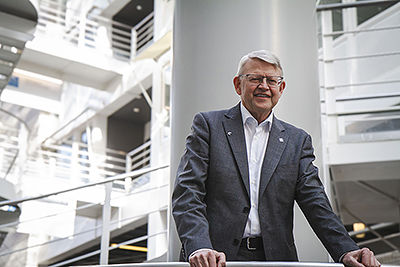Without semiconductors the world stops

Without semiconductors, the world would come to a standstill, at least the way we are used to seeing and moving around in it. The small chip can be found in virtually all the electronics we use every day - for example, in headlights, mobile phones, LED lamps and various types of machines. KTH is now involved in setting up a pilot line for semiconductors in Europe.
"All current and future technologies are actually based on semiconductors," says Mikael Östling, Professor of Microelectronics and former Deputy President at KTH. He has also been a strategic advisor in the EU's major power semiconductor pilot line initiative.

Mikael Östling is welcoming us at Electrum in Kista, which houses the Electrum laboratory where semiconductors are produced. He was involved in planning KTH's activities when the laboratory started almost 40 years ago, and he has seen how the development, demand and production of semiconductors have gone in cycles over the decades.
During the pandemic, there was a critical shortage of semiconductors and Europe's vulnerability and dependence on Asian manufacturers, mainly Taiwan, was exposed.
Starting this spring
A year ago, it was decided that KTH would be one of four Swedish universities to take part in building a fourth pilot line, a test line for small-scale production, as part of the EU's Chips JU programme. The idea is to start production in the spring and the project will run for five years.
"It is about silicon carbide power semiconductors, which we can contribute to here."
Everything will be done at Electrum's laboratory, where we have a well-established machine park that we will upgrade to a certain extent in order to scale up production,' says Mikael Östling, adding that Professor Per-Erik Hellström is leading the technological development of the pilot line.
Electric motors, charging stations, rail transport and electric cars are some of the applications where this type of semiconductor is increasingly in demand.
"We are also working on semiconductor technology for AI as a whole. There can be tens of billions of transistors in a chip that we at KTH can help develop - it's fantastic and a good situation right now. With a dream of 'making semiconductors great again', he hopes that people will realise the scale of the opportunities in this industry and be willing to invest. The EU and Sweden have a huge need for trained people in the semiconductor industry."
"This is what the world is crying out for,'"he says, stressing the importance of not consuming too much of the earth's resources.
Power semiconductors based on the new materials silicon carbide or gallium nitride are very energy-efficient, and increased global use means that each one per cent would give an energy efficiency gain equivalent to 100 medium-sized fossil-fuel power plants, according to Mikael Östling.
"We are also working with the respective management of Chalmers and Lund University to establish a Swedish semiconductor strategy, which most other EU countries already have," Östling says.
Closing the circle
Further down the corridor sits Carina Zaring. She has been director of the Electrum Laboratory since 1 September last year, and has used the research infrastructure and opportunities at the Electrum Laboratory over the years as a researcher and in various roles. She moved to the newly established laboratory in 1987 as a doctoral student at KTH, after studying engineering physics at Uppsala.

"It feels like I've come full circle working here again. The Electrum Laboratory is fantastic and my role as director is to make it even stronger," Zaring says.
Today, the lab is used by a wide range of researchers, companies, innovators and inventors.
" About half of them are from industry and half from academia."
Carina Zaring is developing a business model for the Electrum lab to attract more people to use it for their research with a range of technologies and applications. The hope is to attract more researchers within KTH and in collaboration with other labs. But you really want more people to benefit from the machines we have. I try to see the big picture.
To understand why, I suggest an elevator pitch.
"It is a fully equipped semiconductor infrastructure for both industry and academia, and the lab is unique because it is open to everyone. Both large and small projects are welcome,"Zaring says.
We take a short tour and look through the window where researchers, dressed from head to toe in cleanroom garb, move between different machines.
Carina Zaring tells us that in the clean room, which is exactly what it sounds like - a very clean room - there are perhaps 1,000 to 10,000 particles per cubic foot, depending on the requirements, while outside the glass walls of the laboratory there are 300,000 particles.
Where the semiconductors are made, it's quiet and the machines hum. And Carina Zaring notices:
"They make the world go round."
Text: Jill Klackenberg (jillkKTH.se)
Photo: Christer Gummeson
